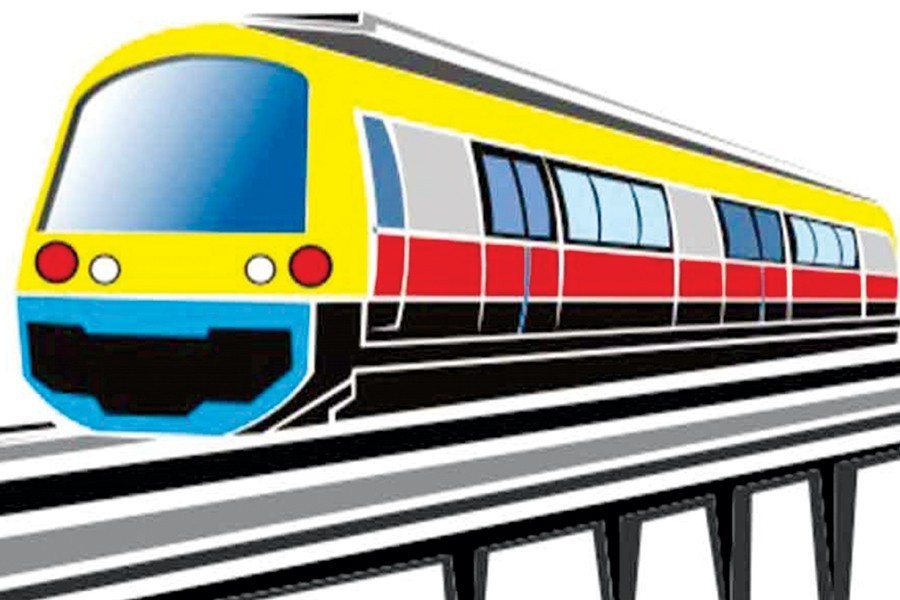The government announcement to open the 11.73 kilometre (km) segment of the eagerly awaited metro rail (MRT-6) on the Uttara-Agargaon route on the coming December 16 is filled with great expectations. With the day being the occasion to celebrate the golden jubilee of the country's freedom, lots of people have begun their countdown to the completion of the mega project. Undoubtedly, it is going to be a landmark achievement for Bangladesh in its communication sector. After finishing, the 20.1km elevated railway commuting route connecting Uttara at the northern end with Motijheel at the southern end is set to emerge as one of the massive projects of the nation. The Dhaka Mass Transit Company Limited (DMTCL) has set the target of completing the entire MRT Line-6 communication infrastructure by December 2022. The earlier deadline of the project implementation entity, DMTCL, was June 2024. They have brought the deadline closer by 2 years on an instruction from the government.
However, it should be admitted that after the preliminary start of the Uttara-Motijheel metro rail project seven years ago, its smooth progress had made people feel upbeat. But later it hit snags in a lot of work segments in some areas. The impediments came to the fore in the form of relocation of underground cables laid by dozens of utilities, difficulty in digging work caused by traffic congestion and monsoon rains and a lot of allied hindrances. Besides, realignment of the metro routes also caused delay to the work's completion. Another blow was dealt by the low turnout of workers and technical hands prompted by the Covid-19 pandemic. These bottlenecks have evidently detracted from the popular enthusiasm over the MRT-6 project. The resetting of the completion timeline ahead of the earlier-announced deadline points to a feeling of urgency on the government's part. Notwithstanding the future commuters' dread over problems besetting the construction of the 20.1km Uttara-Motijheel metro route, they are now, understandably, happy. They will take heart from the government instruction on completing the project ahead of schedule.
Before the formal opening of the Uttara-Agargaon section under MRT-6, the metro authorities have planned to operate trial run of trains in that segment. Meanwhile, work on the under-construction metro rail depot and workshop at Diabari at Uttara-end and 16 elevated stations is in fast progress. Viaducts have been built in almost the whole metro rail network. The DMTCL has embarked on the grand project of constructing the Uttara-Agargaon-Farmgate-Motijheel MRT-6 with financial support of Japan. Of the total amount being spent for the project, the share of Japan International Cooperation Agency (JICA) comes to Tk 165 billion.
As gleaned from the pictures of elevated metro rail in other big cities, the state-of-the-art communication mode is expected to bring about a radical change to the whole lifestyle in Dhaka. Apart from adding speed to commuters' archaically faltering travels, the metro rail will greatly change the city residents' activities --- from office going, business, school, college-university attendance to setting of all kinds of socio-political-cultural programmes. It will cut down on the tormenting anxieties, thus high blood pressure, of the fidgety people who have to maintain stringent time-schedule. The long dreamt-of comfort and convenience of being a big-city resident may no longer be elusive to the general people. Whereas a bus, baby taxi or a car trip from Uttara to Motijheel now takes nearly 3-and-half to four hours on office days, a metro rail traveller can reach Motijheel from Uttara in 35 minutes. The shorter the distance, the lesser is the travel time. Apart from these commuting benefits, Dhaka will eventually emerge as a gridlock-free city -- at least for a considerable period. At the same time, due to many people's new-grown option to shift to the northern segments of the capital, land prices in Dhaka's both parts may witness a semblance of uniformity.
A century ago, people on occasions were required to arrive in Dhaka. According to different chronicles, those arduous travels would take at least 15 hours for able-bodied men to reach the centre of Dhaka from any 'Uttara' village. The people back then would walk all the way and travel in groups. Roads were not safe. As those snaked through dense forests, and swathes inhabited by ferocious animals, dacoits and thieves, not to speak of wide canals and marshlands, the travels virtually turned out to be a test courage and perseverance. This is no fiction. People coming from greater Joydevpur had to go through more spells of ordeals.
All these hindrances to the long travels to Dhaka have changed as the people in those areas began entering the newer times, later known as modern times. Railway journeys from Joydevpur or Tongi -- a few miles from the present Uttara, became the lone mode of travel to Dhaka. It took many years for the wooden-body buses to hit the semi-dirt roads. Few in the areas far from Dhaka could imagine, even in their wildest dreams, that in just more than half an hour they would be able to reach Dhaka sometime in the near future. Such forecasts, however, were there. But those who made them must have been declared as being steeped in nonsensical absurdities.
The MRT-6 elevated rail is set to herald a new era for the whole capital of Dhaka. Few were prepared to see this sudden leap forward in their lives. An embarrassing gap crops up at this point. Although a few people will be able to adapt themselves to the 'brave new' means of travel, many others might lag behind. For them, the need for rehearsals arises. Printed manuals could also make them prepared on how to board and alight from the trains. They should be taught that there is no need to hurry. Travellers do not miss a high-speed metro rail. Trains continue to enter and leave stations every four minutes.


